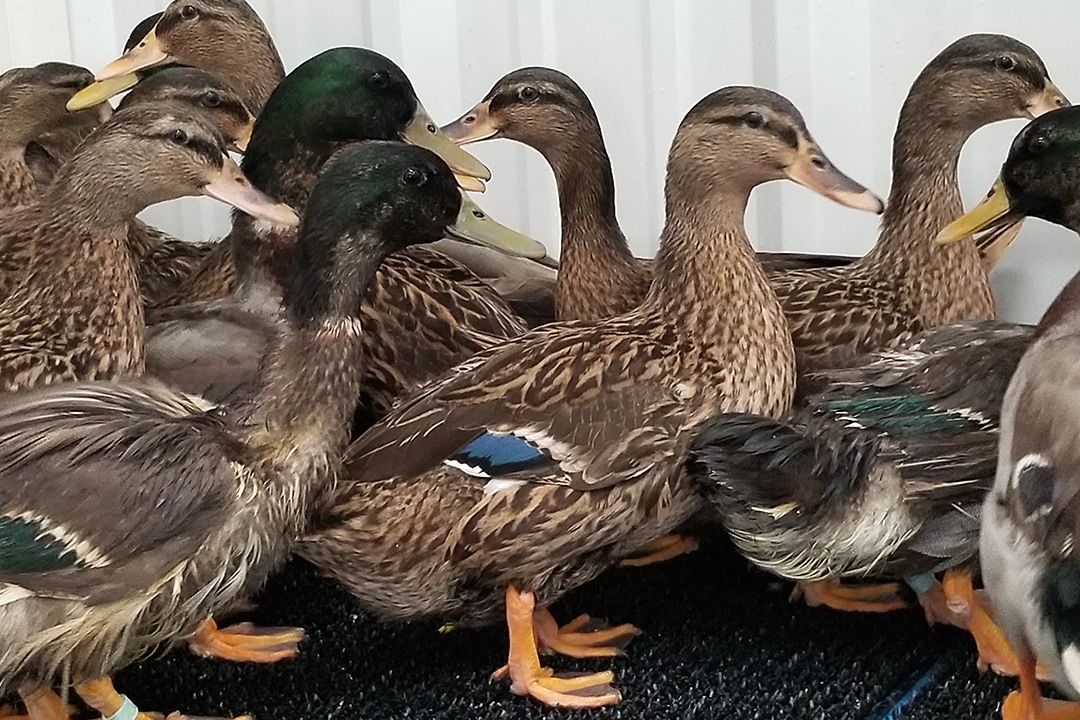
The effects of climate change on waterfowl
Stressed-out ducks have the potential to give University of Saskatchewan (USask) researchers a glimpse of the destructive effects of climate change on wetlands — the primary habitat for ducks and other waterfowl.
By Brenna PiecowyeDucks rely on wetlands for their survival and the successful rearing of their young. But with the widespread expansion of agriculture, coupled with climate change and human development, waterfowl habitat has drastically changed in Western Canada. This change has introduced novel environmental stressors such as altered habitat and food supply, pollution, climate change and population distributions.
Led by Dr. Karen Machin, an associate professor in the Western College of Veterinary Medicine (WCVM), the research team is looking at how maternal stress can affect developing young, and how this correlates with the increase of environmental stressors.
A member of this team is Breanne Murray, a PhD student in the WCVM’s Department of Veterinary Biomedical Sciences. Murray is looking at how maternal stress during embryonic development affects a duckling’s behaviour in response to predation. Her project’s goal is to understand the relationship between a mother duck experiencing stress, and the signs of abnormal behaviour in her ducklings.
As Murray explains, waterfowl use coping strategies to maintain their fitness in response to stress. The hypothalamic-pituitary-adrenal (HPA) axis, which is the body’s central stress response system, is one of the strategies activated in response to a stressor. With an increase in environmental stressors, the stress hormone corticosterone is released through the HPA axis. While appropriate responses to stress can aid in survival, adverse effects of the hypothalamic-pituitary system can be apparent with chronic stress.
For example, if a mother duck experiences chronic stress during fetal development, this can increase the corticosterone receptors within the ducklings — causing them to have more exaggerated stress responses.
“I was interested in investigating how maternal stress affects HPA axis development in ducklings and behavioural reaction to predation cues,” Murray says. “I am looking at ducklings’ reactions to auditory and visual predatory cues.”
The study’s ducks and ducklings were housed at the University of Saskatchewan’s Facility for Applied Avian Research (FAAR). Murray used the call of a red-tailed hawk and the shape of a hawk as her study’s auditory and visual predatory cues. The call of a common loon served as her study’s control cue.
“The ducklings were exposed to 30-second calls in one day — one [call] in the morning and one in the afternoon — and the order of the calls were randomized,” says Murray.
To mimic the effects of maternal stress, she also injected similar doses of corticosterone into the developing eggs and observed them as they matured.
Due to an increase in maternal stress, ducklings can be at a behavioural and physiological disadvantage. With a reduced success rate of ducklings in a variety of species, fingers may point at the instability of wetlands and increased environmental stress affecting the mother ducks.
“Climate change is causing prairie potholes — small ephemeral wetlands vital to waterfowl — to reduce in size, and they’re also being destroyed by anthropogenic [human-related] disturbances such as development, agriculture and mineral extraction,” says Murray. “This habitat destruction causes stress in wild birds, so waterfowl populations are expected to decline. Those that remain will be faced with an increased exposure to stressors.”
Climate change is affecting millions of species, and in Saskatchewan, waterfowl species that rely on wetland habitat are the first to be affected. Murray’s research offers an insight of what is going on in the environment, and based on the study’s findings, this research work could pinpoint opportunities where wildlife specialists can intervene and prevent further damage to waterfowl species.
Brenna Piecowye of Saskatoon, Sask., is a second-year dual Doctor of Veterinary Medicine and Master of Science (DVM/MSc) student at the WCVM. Her story is part of a series of articles written by WCVM summer research students.
